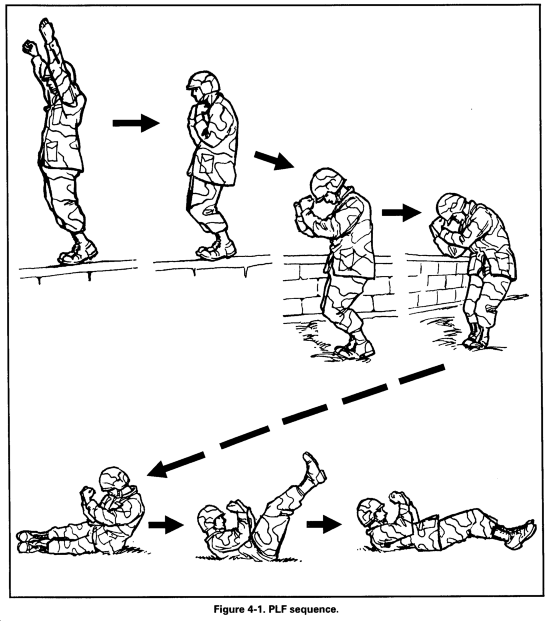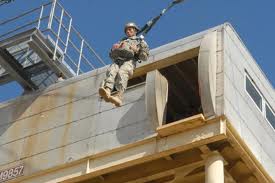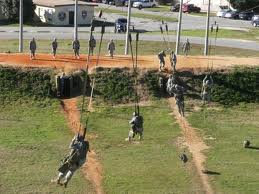Getting through ground week involved a certain determination to make it no matter what. Because of the uncertainty involved, there was a constant anxiety, but by the end of the week you had a pretty good idea of the routine and what to expect in general.
The first day, most of the company was up at o-dark-thirty to get ready for the first day of ground week where you receive instruction in in the parachute landing fall or PLF, aircraft exit procedures, and the 34 foot tower simulator.
Before the day’s events started, you had to make sure your bunk was made up and you were out and standing on the cables (literally steel cables anchored into the ground on which you were required to stand in formation) by 0510 for roll call. I made sure to take a shower the day before so that I wouldn’t get caught short, but even so it was like grand central station trying to get your morning routine completed.
Roll call was a gleefully sadistic ritual for the black hats. Lots of yelling and beating of faces, especially for the poor souls who turned out looking like bags of donuts.
They would do things like walk up and down the lines and suddenly turn to face you and yell, “WHADDAYA WANNA BE LEG!!!” To which you were required to reply in a loud and thunderous voice, “AIRBORNE!”
Ground week featured a PT test that included push-ups, pull-ups, and a timed 2-mile run. Also that first week, if you fell out of 3 runs, you washed out of the course.
From my point of view, the PT test was not much trouble. You just had to make sure you did the pull-ups and push-ups with exact technique while under the eagle-eyed supervision of a Black Hat. I saw quite a few soldiers getting no counts on their push-ups because they didn’t touch the ground with their chest. Needless to say, I made sure not to make that mistake.
The timed run required a bit of restraint on my part. Being a runner, I was not at all worried about making the time, but the word quickly spread that if you ran fast, you’d be identified as a road guard. I remembered my Dad’s advice not to volunteer for anything and decided to take it easy. I saw the unwitting rabbits treat the run like a race while I maintained comfortably in the middle of the pack.
Sure enough, those who finished fast got snagged for road guard duty.
Another bewildering situation involved some members of a Marine Recon team. Several of these guys were absolutely huge, and it was apparent that they spent a lot of time in the weight room. So I thought they’d have no problem with the physical aspect of the course, including the run.
It absolutely amazed me how many of those Marines kept falling out.
It became obvious that they didn’t spend a whole lot of time on their aerobic conditioning. Half of them washed out by the end of ground week because they couldn’t finish a 3-mile run. On the other hand, the Marines who remained were fairly short, wiry guys.
Just goes to show, don’t judge a book by its cover.
The core of ground week involved basic instruction in the parachute landing fall (PLF). It’s the fundamental maneuver you need to know to absorb the shock of landing and reduce the chances of breaking something when you hit the ground, especially since the vertical fall rate in the non-steerable T-10D parachute is 18 feet per second.
Done correctly, the PLF uses the large muscles of your body—calves, thighs, glutes, lats to absorb the impact. The PLF is repeated many hundreds of times throughout training so that by the time you actually do it during jump week, it’s practically automatic. The below illustration gives you an idea of the PLF sequence.

The PLF makes total sense when you realize that the idea is to get on the ground as quickly as possible without incident and start fighting.
In fact, when I observed the trainees in the gravel pits 25 years later, I noticed them hopping from place to place while standing in line to get on the T-Bar PLF trainer. It was then that I remembered that the only way you could move was by the “PLF hop.” And if you didn’t do it right, you’d be beating your face in short order.
The other big training event during ground week was jumping off the 34-foot tower. The whole process was designed to get you used to all the things you needed to do to exit from an aircraft while wearing a harness.

This involved obeying all commands and fixing typical problems such as twisted risers. Once you jumped out of the tower, you slid down a zip line to a dirt mound at the end where you unharnessed and double timed back to a row of concrete benches to wait for the next go.
You had to do this successfully at least 6 times to pass this particular phase of ground week.
The tower was actually somewhat fun, in part because the black hats were focused on getting everyone through the evolution so they didn’t have as much time to yell at you. However, I did learn the hard way to follow instructions.
One of the key maneuvers as you approach the surface in your chute is to pull up on your risers to slip into the wind and slow your descent at about 100 feet above the ground. For training, this move was required at the end of the zip line in order for you to clear the dirt mound at the end of the line. The below photo is shot from the top of the 34 foot tower. In the background you can see the dirt mounds.

On my first time out of the tower, I was very concentrated on getting everything right, because the quality of exits and technique were being scored. I was so relieved when I nailed it that I just slid on down the zip line like I was on some sort of wilderness ride. As I moved closer to the mound, I could hear some of the soldiers yelling at me, but I couldn’t quite make out what they were saying.
It turns out they were telling me to pull up on my risers.
I wished I would have because at the end of the ride down the line, my right butt check slammed hard into the dirt mound.
And it hurt.
Bad.
Everyone asked me if I was OK, and of course I said I was and double timed back to the concrete benches. Well, after about a minute on those benches I could no longer sit on my right cheek without some extreme pain…and I had five more tower jumps to go that day. So I sat with my weight on the left part of my gluteus and tried to ignore it.
On the run back it was like someone was punching me in the right butt check every time my foot struck the ground. Not a good feeling.
The literal ass pain involved with my stupidity was a constant reminder from there on out to pay very close attention to the instruction I was receiving.
Stupid injuries notwithstanding, your body does start accumulating micro trauma from hundreds of PLFs, running everywhere in formation, neck aches from keeping your chin tucked with your helmet on, endless push-ups and flutter kicks, pinching your legs, crotch, and chest from jumping out of the tower.
When it was all said and done at the end of the week, I’d passed all requirements made it through to week two–Tower week. It did take a certain level of fitness and definitely a good dose of mental resilience, but sticking with it was half the battle.
WHAT I LEARNED FROM GROUND WEEK
1. Get yourself ready to pass the test. This may seem obvious, but proper preparation might have kept those Recon Marines in the course. The same goes for leadership: prepare yourself by learning and studying as well as observing and emulating other leaders.
2. Follow instructions and rules when they are designed to make you successful or keep you safe. The butt bruise I experienced was a physical reminder of this lesson. Yes, leaders must operate within a variety of rules, regulations, and expectations–both written and unwritten. You need to pay attention to them and follow them when they contribute to your organization’s success and keep it (and you) out of hot water.
3. Overcome your fears. There were several trainees who were unable to jump out of the 34-foot tower due to their extreme fear of heights. On the other hand, many did. Jumping out of an airplane is not a natural act. You’re going to be scared. But in order to progress through the course, you had to face your fears and drive on anyway. Leadership is fraught with uncertainty and tough–even scary–challenges. In just the same way, you need to be able to face your fears and summon the internal resources to overcome them.
I’ll continue this series with Tower week and a post on “good times” at Army Airborne School
By Joe Scherrer | The Leadership Crucible
(This post is a personal reflection and does not constitute the official position of the United States Air Force or United States Army)
.